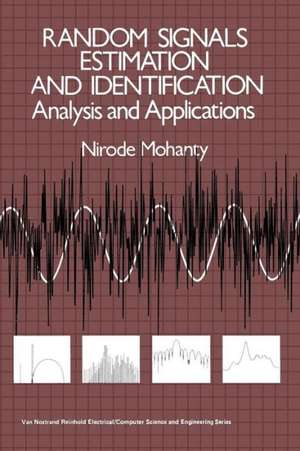Random Signals Estimation and Identification: Analysis and Applications
Autor Nirode Mohantyen Limba Engleză Paperback – 14 mar 2012
Preț: 406.25 lei
Nou
Puncte Express: 609
Preț estimativ în valută:
77.76€ • 84.49$ • 65.36£
77.76€ • 84.49$ • 65.36£
Carte tipărită la comandă
Livrare economică 21 aprilie-05 mai
Preluare comenzi: 021 569.72.76
Specificații
ISBN-13: 9789401170437
ISBN-10: 9401170436
Pagini: 640
Ilustrații: XII, 626 p.
Dimensiuni: 152 x 229 x 34 mm
Greutate: 0.84 kg
Ediția:Softcover reprint of the original 1st ed. 1986
Editura: SPRINGER NETHERLANDS
Colecția Springer
Locul publicării:Dordrecht, Netherlands
ISBN-10: 9401170436
Pagini: 640
Ilustrații: XII, 626 p.
Dimensiuni: 152 x 229 x 34 mm
Greutate: 0.84 kg
Ediția:Softcover reprint of the original 1st ed. 1986
Editura: SPRINGER NETHERLANDS
Colecția Springer
Locul publicării:Dordrecht, Netherlands
Public țintă
ResearchCuprins
1 Random Signals.- 1.0 Introduction.- 1.1 Characterization and Classification.- 1.2 Correlation and Covariance Functions.- 1.3 Gaussian Processes and Wiener Processes.- 1.4 Poisson Process.- 1.5 Mean Square Calculus.- 1.6 Markov Process.- 1.7 Renewal Process.- 1.8 Bibliographical Notes.- Exercises.- 2 Stationary Random Signals.- 2.1 Introduction.- 2.2 Linear Systems with Random Signal Input.- 2.3 Cross Covariance and Coherence.- 2.4 Narrowband Noise Process.- 2.5 Orthogonal Expansion and Sampling.- 2.6 Ergodicity and Entropy.- 2.7 Zero Crossing Detectors.- 2.8 Nonlinear Systems.- 2.9 Bibliographical Notes.- Exercises.- 3 Estimation, Optimization, and Detection.- 3.0 Introduction.- 3.1 Sampling Distribution.- 3.2 Estimation of Parameter: Point Estimation.- 3.3 Estimation Criteria.- 3.4 Maximum Likelihood Estimation.- 3.5 Linear Mean Square Estimation.- 3.6 Method of Least Squares: Regression Models.- 3.7 Interval Estimation: Confidence Interval.- 3.8 Cramer-Rao Inequality.- 3.9 Estimation in Colored Noise.- 3.10 Optimum Linear Filters.- 3.11 Signal Detection.- 3.12 Bibliographical Notes.- Exercises.- 4 Spectral Analysis.- 4.0 Introduction.- 4.1 The Periodogram Approach.- 4.2 Spectral Windows.- 4.3 Autoregressive Method.- 4.4 The Maximum Entropy Method.- 4.5 Maximum Likelihood Estimator.- 4.6 Pisarenko and Prony Methods.- 4.7 Adaptive Lattices Method.- 4.8 Cross Spectral Estimation.- 4.9 Bibliographical Notes.- Exercises.- 5 Prediction, Filtering, and Identification.- 5.0 Introduction.- 5.1 State Space Representation.- 5.2 The Innovation Process.- 5.3 Linear Prediction and Kalman Filtering.- 5.4 Smoothing.- 5.5 Extended Kalman Filtering.- 5.6 System Identification.- 5.7 Bibliographical Notes.- Exercises.- Appendix 1. Linear Systems Analysis.- Appendix 2. Probability.- Appendix 3. Stochastic Integrals.- Appendix 4. Hilbert Space.




